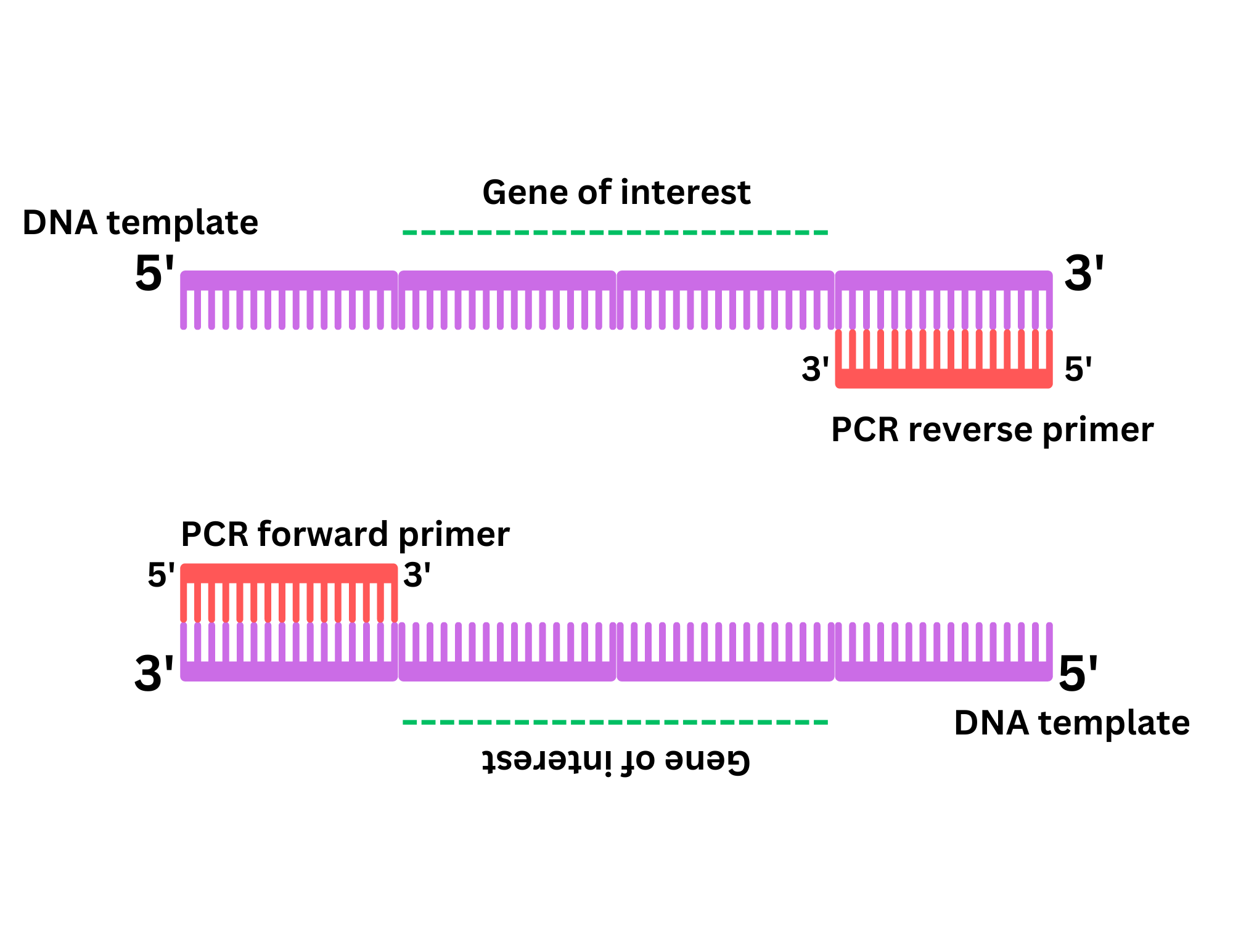Designing Primers for SNPs: Key Criteria and Bioinformatics Tools
Polymerase chain reaction (PCR):
The polymerase chain reaction allows for the amplification of minute amounts of genetic material, opening the doors to a wide array of applications. It revolutionizes the identification and manipulation of DNA, facilitates the detection of infectious organisms, and enables the discovery of genetic variants, including mutations within human genes. This groundbreaking method earned Kary Mullis and his colleagues a Nobel Prize in 1985 for their pioneering work.
PCR consists of three crucial steps: denaturation, annealing, and extension. During denaturation, the DNA strand separates into single strands. The annealing process involves the attachment of primers to the complementary sequences of the single-stranded DNA. Finally, during the extension phase, DNA polymerase elongates these primers to create new DNA strands.

PCR Primers:
PCR primers are short single-stranded DNA fragments designed to match the beginning and ending of the target region for efficient amplification. Selecting the right primers is crucial for identifying the precise DNA sequence to be reproduced during the PCR process. These primers serve as the starting point for amplification.
Length: The length of a PCR primer should generally be between 18 and 22 base pairs to ensure a strong enough binding affinity at the annealing temperature.
Melting Temperature (Tm): The melting temperature (Tm) of the primer is the temperature at which half of a DNA duplex separates into single strands, and it is a measure of the stability of the duplex. Primers with Tm values in the range of 52–58°C usually work well. If a primer's Tm value exceeds 65°C, secondary structures may form. The GC content of the primer sequence can be used as a reliable estimate of the Tm.
Annealing Temperature (Ta): (Tm) of a primer is crucial for determining the annealing temperature (Ta). If the Ta is too high, there will be inadequate primer-template binding and low PCR product yields. Conversely, a low Ta may result in the generation of nonspecific products. In PCR, the ideal annealing temperature typically ranges around 5°C lower than the melting temperature (Tm) of the primers. To achieve optimal performance, it is recommended that the Tm values of the forward and reverse primers differ by five degrees, with closer values being more favorable.
GC content: The optimal GC content falls within the range of 40-60%.
GC clamp: Introducing G or C bases at the 3' end of the primer enhances specific binding due to the stronger G-C bonds compared to A-T bonds. It is advisable to avoid having three or more consecutive G or C residues in this position.
Secondary Structures: To prevent low or negligible product yield, minimize intra- or intermolecular interactions that lead to secondary structures formed by the primers. Therefore, aim to minimize complementarity within a primer or between two primers.
Repeats and Runs: Di-nucleotide repeats, such as ATATATAT, and extended sequences of a single nucleotide, for example AGCGGGGG, should be avoided in primers as such repeats can lead to mispriming.
Cross Homology: Designing primers with a specific sequence is essential to prevent unintended amplification of other genes in the mixture. This is done to ensure optimal primer specificity, and to avoid regions with cross homology.
Single nucleotide polymorphism (SNPs):
Genetic variants of the single nucleotide polymorphism type are incredibly common. This occurs when a single nucleotide in a DNA sequence at specific locations in the genome is altered, for example, by converting an adenine (A) to a guanine (G) at a specific location. SNPs may be pathogenic when they locate in critical regions of the genome, namely within the promoter region or an exon. SNPs play a crucial role in determining an individual's attributes and susceptibility to certain illnesses by contributing to genetic variations. These variants are identified through genotyping arrays, sequencing, and bioinformatics tools, making them invaluable markers in population genetics and personalized medicine. SNPs are extensively studied to uncover evolutionary links, inherited patterns, and the development of targeted treatments.
Designing primers in the case of SNPs involves the following steps:
For example, you have been tasked with designing a primer for a gene with an SNP mutation, specifically a missense mutation at a particular position. So, you will proceed as follows.
- To begin, open NCBI and enter the gene name in the search bar. Then, select "nucleotide" from the drop-down menu and click “enter.”
- Remember to click on the reference sequence gene to open up the gene sequence with all the information. You will download the gene sequence in FASTA format by clicking on "FASTA" and then selecting "download". Make sure to store the downloaded content in a Word document.
- To access the desired information, reopen NCBI and choose "clinvar" from the drop-down menu. In the search bar enter your query in the format "GALK1 c.1067 T>C" or use the accession number if it is more appropriate based on the available data. Then click on “search”.
- The new interface will display all essential information about a pathogenic SNP mutation.
- In the HGVs section of variant details, the desired sequence accession number will be selected based on the specific experiment and demand. In our case, we will opt for the first one.
- The sequence viewer will open up and provide a visual representation of the gene. All you need to do is click on the transcript accession number in the blue box and then click on marker details.

- The mutation location will be confirmed - a missense mutation occurred at the 1067th nucleotide position, resulting in the change of the nucleotide base from T to C. The original codon, responsible for the Leu amino acid, has been replaced by a codon that recruits the Pro amino acid.
- Now open a new tab and navigate to the "UCSC Genome Browser." Once there, simply enter the gene name in the search bar. Click on “search”.
- Click on your desired result. Right now, in our case we will choose the first one.
- A new visual representation of the chromosome will open up. This time click on the first blue box with the gene name.
- A new window will open up. In the “sequence and links to tools and databases” section of this window, click on “Ensemble”. A new database will be opened in the new tab. On this new interface, click on “Show Transcript Table”. Now, from the transcript table, only choose the result with the status of “Protein Coding”. In our case, we will choose the first one.
- To locate the exon sequences of the gene, simply click on "exon" from the side Menu bar. Once the sequences are displayed, use the CTRL+F function to efficiently find the location of the SNP missense mutation in the exon. Return to the sequence viewer tab, copy the first sequence, and paste it into the search bar that appears after using the CTRL+F function. This method will allow us to pinpoint the exon where the SNP missense mutation occurred, ultimately leading to congenital cataract.
- Copy the exon containing the desired sequence and paste it into the word document where the gene sequence is stored. Then, highlight the mutation in the sequence. After that, use the CTRL+F function in the same word document to find the exon in the gene by taking small sequences from the beginning and end of the exon.
- Open "Primer 3" in a new tab. Extract a 250-nucleotide bases sequence from both the beginning and end of the exon in the gene, including the middle region, and paste it into the "Primer 3" input section. Click on "pick primers" to generate results. From the results, select a pair of primers that meet all the given criteria and cover the mutation in the gene sequence. In our case, the first pair of primers will be "The Primers."
- To find the sequence for your chosen set of primers in the gene sequence, use the ctrl+F function in the Word document. Copy and paste the forward primer sequence into the navigation bar. Once you locate the sequence, remember to highlight it. Similarly, for the reverse primer, but don’t forget to find the reverse complement of the reverse primer as only one strand sequence is available. In the new tab write “reverse complement” paste sequence, click submit and, get reverse complement sequence.
- To verify the functionality of a specific set of primers, utilize "In-silico PCR." Open "In-silico PCR" in a new tab and input the sequences for the forward and reverse primers. If an error occurs, the specific primer set will not work. Conversely, if no error occurs, the primer set will work.
- Make sure to check the SNPs of the primer to avoid non-specific binding and reduce the chance of the primer not binding to the DNA due to an SNP. Open a new tab and label it "SNP check." Click on "SNP input," then select "SNP check." Before entering the input, remember that X represents the chromosome number, and A_B are the names of the forward and reverse primers, respectively.
- The best primers are those that yield 0 SNPs. If SNPs are found, remain calm, verify their location and check if the identified SNPs are polymorphic in the population. The SNP is unlikely to affect primer binding if it is located in the amplified region but outside of the primer binding sites. However, primer annealing may be impeded if the SNP is genuinely found at one of the primer's binding sites, potentially reducing the effectiveness of amplifying DNA fragment.
Conclusion:
PCR is a highly reliable method for amplifying specific DNA sequences, relying on carefully chosen primers. When setting up a PCR reaction, it's crucial to have a deep understanding of primer design requirements, including length, melting temperature, and GC content. Detecting SNPs adds complexity. Today, bioinformatics technologies enable the effective design of SNP-containing primers, greatly facilitating genetic studies and mutation analysis.
References:
- Khehra, N., Padda, I. S., & Swift, C. J. (2023, March 6). Polymerase chain Reaction (PCR). StatPearls - NCBI Bookshelf. https://www.ncbi.nlm.nih.gov/books/NBK589663/
- Martin, K. (2022b, July 12). How to design PCR primers. miniPCR Bio. https://www.minipcr.com/how-to-design-pcr-primers/
- Primer design guide for PCR :: Learn designing primers for PCR. (n.d.). http://www.premierbiosoft.com/tech_notes/PCR_Primer_Design.html
Kheh


